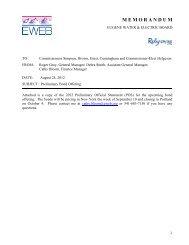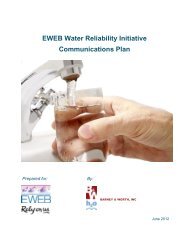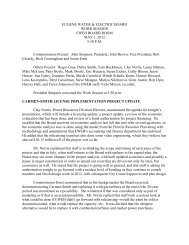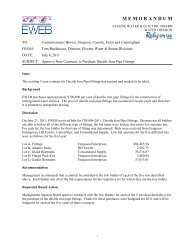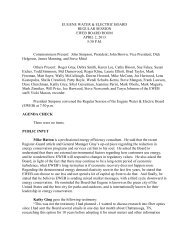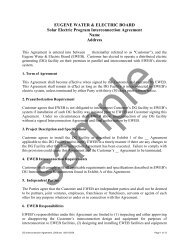Preparing for the NEXT CENTURY - Eugene Water & Electric Board
Preparing for the NEXT CENTURY - Eugene Water & Electric Board
Preparing for the NEXT CENTURY - Eugene Water & Electric Board
Create successful ePaper yourself
Turn your PDF publications into a flip-book with our unique Google optimized e-Paper software.
Focus on renewable power<br />
When<br />
<strong>Eugene</strong><br />
<strong>Water</strong> &<br />
<strong>Electric</strong><br />
<strong>Board</strong><br />
customers<br />
say <strong>the</strong>y<br />
want<br />
renewable<br />
Dawn Craig and Chris power<br />
Davidson converted to solar resources,<br />
water heat.<br />
<strong>the</strong> utility<br />
listens.<br />
Ever since EWEB initiated an extensive<br />
energy resource planning process in <strong>the</strong> late<br />
1980s, customers have communicated with<br />
<strong>the</strong>ir utility through citizen involvement<br />
committees, surveys and focus groups<br />
on <strong>the</strong> issue of energy resources. Their<br />
advice: Invest in conservation, <strong>the</strong>n pursue<br />
renewable energy sources to help meet <strong>the</strong><br />
growing demand of consumers and help <strong>the</strong><br />
environment at <strong>the</strong> same time.<br />
“In each process, citizen groups have<br />
concluded <strong>the</strong> same thing: conservation<br />
first, <strong>the</strong>n renewables like wind and solar,”<br />
says EWEB’s Energy Resource Projects<br />
Manager Jim Maloney.<br />
The utility’s elected board and staff<br />
responded in numerous<br />
ways. EWEB currently<br />
spends 5 percent of<br />
retail revenues on<br />
conservation – one of <strong>the</strong><br />
highest commitments<br />
to conservation among<br />
utilities. It launched a<br />
solar hot water heating<br />
program in <strong>the</strong> early<br />
1980s, which has provided<br />
financial assistance<br />
and expert advice to more than 1,000<br />
customers who’ve installed systems. It<br />
also has provided incentives and advice<br />
<strong>for</strong> customers wishing to install solar<br />
electricity (photovoltaic) arrays.<br />
In recent years, EWEB has embarked on<br />
a path to diversify its “portfolio” of energy<br />
sources, using $150 million in bonds<br />
approved by voters in 1992. Like most o<strong>the</strong>r<br />
public utilities, EWEB is heavily dependent<br />
on hydropower. Having a better mix of<br />
resources, particularly renewable energy,<br />
can help reduce <strong>the</strong> volatility of energy<br />
prices (such as during a drought) and help<br />
<strong>the</strong> environment at <strong>the</strong> same time.<br />
In 1999, EWEB, PacifiCorp and <strong>the</strong><br />
Bonneville Power Administration partnered<br />
to build a 69-turbine wind farm in<br />
sou<strong>the</strong>astern Wyoming. For <strong>the</strong> first time,<br />
EWEB customers could choose to buy wind<br />
power to support <strong>the</strong> project and test local<br />
markets <strong>for</strong> renewable energy products.<br />
As <strong>for</strong> <strong>the</strong> future, EWEB continues to<br />
look to invest in renewable energy projects<br />
that make financial sense or in promising<br />
research. As <strong>the</strong> result of <strong>the</strong> most recent<br />
update of <strong>the</strong> utility’s resource plan, EWEB<br />
commissioners in May 2006 dedicated<br />
UO’s Lillis Business Complex.<br />
( )<br />
“In each process, citizen groups have<br />
concluded <strong>the</strong> same thing: conservation<br />
first, <strong>the</strong>n renewables like wind and solar.”<br />
– EWEB Energy Resource Projects Manager Jim Maloney<br />
1 percent from electric rates to acquire new<br />
renewable energy sources.<br />
Earlier this year, commissioners agreed<br />
to purchase wind power from <strong>the</strong> Klondike<br />
III wind farm being built in nor<strong>the</strong>astern<br />
Oregon and may buy geo<strong>the</strong>rmal power<br />
from a project under consideration in<br />
Idaho. EWEB also purchases renewable<br />
energy from <strong>the</strong> Stateline wind farm on<br />
<strong>the</strong> Oregon-Washington border and <strong>the</strong><br />
Tieton Hydroelectric Project in Central<br />
Washington.<br />
In addition to supporting <strong>the</strong> Solar<br />
Monitoring Laboratory at <strong>the</strong> University<br />
of Oregon, EWEB also supported <strong>the</strong><br />
Wind Research Cooperative at Oregon<br />
EWEB’s Wyoming wind farm (also top).<br />
State University in <strong>the</strong> 1990s. The<br />
utility continues to study solar electric,<br />
ocean wave generation and o<strong>the</strong>r new<br />
technologies.<br />
“EWEB’s energy resource plan is not<br />
a typical ‘least cost’ plan because <strong>the</strong><br />
utility has multiple objectives guided by<br />
community preferences,” says Maloney.<br />
“The philosophy is to provide electricity<br />
<strong>for</strong> <strong>the</strong> <strong>Eugene</strong> community today and in<br />
<strong>the</strong> future at <strong>the</strong> lowest economic and<br />
environmental cost.”





